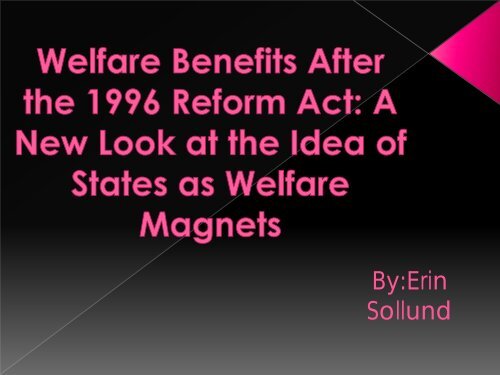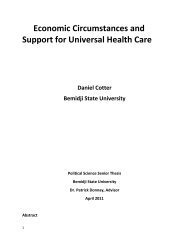Erin Sollund on the Effects of Welfare Reform
Erin Sollund on the Effects of Welfare Reform
Erin Sollund on the Effects of Welfare Reform
- No tags were found...
You also want an ePaper? Increase the reach of your titles
YUMPU automatically turns print PDFs into web optimized ePapers that Google loves.
The federal governmentPut in place to assist <strong>the</strong> unemployed or underemployed.Medicaid, The Women, Infants, and Children (WIC) Program,and Aid to Families with Dependent Children (AFDC) whichturned into Temporary Assistance for Needy Families (TANF),in 1996
The three prominent differences between AFDC and TANF are asfollows:EntitlementFederal-share programNot time limited
What effect does <strong>the</strong> <strong>Welfare</strong> <strong>Reform</strong>Act have <strong>on</strong> <strong>the</strong> U.S states? Did <strong>the</strong>reform effect some states more thano<strong>the</strong>rs? Has this caused states tobecome welfare magnets?
Primarily looked at migrati<strong>on</strong> <strong>of</strong> <strong>the</strong> welfare recipients, andproblems with how people view welfare.2008 study d<strong>on</strong>e by SchowNo real effects were found <strong>on</strong> poverty gaps or poverty rates.
For <strong>the</strong> analysis I used <strong>the</strong> states data set provided by Carls<strong>on</strong>and Hyde (2005) this data set provided numerous variablesthat could be used as independent variables.Independent variables I looked at came from two areas,ec<strong>on</strong>omic, and political.Unit <strong>of</strong> analysis is <strong>the</strong> American states.Dependent variable is <strong>the</strong> change in welfare recipients in1996-2008 from each state.
The data from <strong>the</strong> Census Bureau is in Micros<strong>of</strong>t Excel formatand was imported into <strong>the</strong> SPSS program and added into <strong>the</strong>state data set. The variables include distincti<strong>on</strong>s between <strong>the</strong> years <strong>of</strong> 1996-2008 as well as variables that compare <strong>the</strong> years <strong>of</strong> 1996, and2008.O<strong>the</strong>r distincti<strong>on</strong>s in my added variables includeunemployment rate, states who have workers who are uni<strong>on</strong>members, states that are Democratic, and states that areRepublican.
Complete Correlati<strong>on</strong>s in Per Capita Change in <strong>Welfare</strong>DemographicsPears<strong>on</strong>s Correlati<strong>on</strong>Percent <strong>of</strong> populati<strong>on</strong> with college educati<strong>on</strong> or higher -.072Percent <strong>of</strong> populati<strong>on</strong> with high school or higher -.052Percent populati<strong>on</strong> age 18-24 .110Percent populati<strong>on</strong> age 65 and older .103Percent populati<strong>on</strong> Hispanic -.136Percent <strong>of</strong> populati<strong>on</strong> Black -.253Per capita income -.111Unemployment rate -.329 *Percent <strong>of</strong> workers who are uni<strong>on</strong> members -.474 **Percent <strong>of</strong> populati<strong>on</strong> per square mile -.229Percent <strong>of</strong> urban popluati<strong>on</strong> -.184Percent <strong>of</strong> state legislators who are women .026Percent <strong>of</strong> state legislators who are Black .002Political VariablesPercent <strong>of</strong> mass public Democratic -.436 **Percent <strong>of</strong> mass public Republican .384 **Significant at .05*Significant at .01**
Correlati<strong>on</strong>s in Per capita Change in <strong>Welfare</strong>DemographicsPears<strong>on</strong>s Correlati<strong>on</strong>Unemployment rate -.329*Percent <strong>of</strong> workers who are uni<strong>on</strong> members -.474**Political VariablesPercent <strong>of</strong> mass public Democratic -.436**Percent <strong>of</strong> mass public Republican .384**Significant at .05*Significant at .01**
Per capita Dropper 1000 PeopleRed=3,690 to 4,751Green=2,864 to 3,669Yellow=2,456 to 2,841Blue=1,979 to 2,401Grey=1,301 to 1,742Pink=855 to 1,276
4,751=4,732=4,624=4,566=4,352=4,061=3,804=3,690=New YorkIllinoisLouisianaAlaskaHawaiiCaliforniaWest VirginiaRhode Island
3,669=3,559=3,476=3,468=3,323=3,317=3,180=2,864=GeorgiaMississippiNew MexicoMichiganC<strong>on</strong>necticutPennsylvaniaOhioFlorida
2,841=2,815=2,803=2,783=2,623=2,532=2,502=2,470=2,456=Verm<strong>on</strong>tMarylandKentuckyNorth CarolinaTexasWashingt<strong>on</strong>MissouriM<strong>on</strong>tanaMinnesota
2,401=2,385=2,363=2,344=2,259=2,183=1,985=1,979=MaineNew JerseyWyomingOklahomaWisc<strong>on</strong>sinMassachusettsSouth CarolinaTennessee
1,742=1,738=1,614=1,542=1,471=1,426=1,370=1,312=1,301=ColoradoAriz<strong>on</strong>aIowaIdahoDelawareArkansasAlabamaSouth DakotaNebraska
1,276=1,275=1,224=1,214=1,132=1,111=928=855=VirginiaKansasNorth DakotaUtahNew HampshireOreg<strong>on</strong>IndianaNevada
Figure 1Effect <strong>of</strong> Unemployment Rates <strong>on</strong> Per Capita Change in <strong>Welfare</strong>
Figure 2Effect <strong>of</strong> Uni<strong>on</strong> Member Workers <strong>on</strong> Per Capita Change in <strong>Welfare</strong>
Figure 3Effect <strong>of</strong> Republicans in Office <strong>on</strong> Per Capita Change in <strong>Welfare</strong>
Figure 4<strong>Effects</strong> <strong>of</strong> Democrats in Office <strong>on</strong> Per Capita Change in <strong>Welfare</strong>
Political variables have <strong>the</strong> most impact<strong>on</strong> what states receive welfare. As more states have uni<strong>on</strong>s <strong>the</strong> moresignificant <strong>the</strong>y will prove to be whenbeing compared to having welfarebenefits.
States that started out with higher numbers <strong>of</strong> populati<strong>on</strong> <strong>on</strong>welfare, ended up having more change than states thatstarted out with low numbers <strong>of</strong> <strong>the</strong> populati<strong>on</strong> <strong>on</strong> welfare.(IE: MN,NY, IL, UT)Most significant correlati<strong>on</strong> was <strong>the</strong> states that had uni<strong>on</strong>members as workers.The <strong>on</strong>ly positive correlati<strong>on</strong> are <strong>the</strong> states that support <strong>the</strong>Republican vote.Democratic states, unemployment rates, and states thathave uni<strong>on</strong> member workers all had negative correlati<strong>on</strong>s.
An area that is still a work in progress is<strong>the</strong> magnet aspect. In <strong>the</strong> fur<strong>the</strong>r analysis, I will be comparingstates to <strong>the</strong>re neighbors in terms <strong>of</strong> <strong>the</strong>size <strong>of</strong> <strong>the</strong> drop in welfare recipients.



